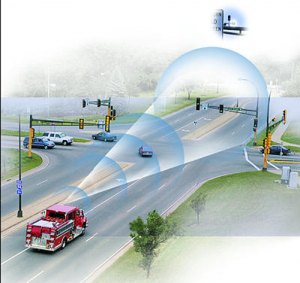Additional Resources
FUNDING OPTIONS
INDUSTRY RESOURCES
- American Public Transit Association (APTA)
- Drive to Survive
- FHWA Fact Sheets on Highway Provisions
- Institute of Transportation Engineers (ITE)
- Intelligent Transportation Society of America (ITS America)
- Intelligent Transportation Society of Canada (ITS Canada)
- International Association of Fire Chiefs
- International Municipal Sign Association (IMSA)
- National Falled Firefighters Association
- National Traffic Incident Management Coalition
- National Volunteer Fire Council
- US Department of Transportation, Federal Highway Administration
- US Department of Transportation, Federal Transit Administration
- US Department of Transportation, Research and Innovative Technology Administration, Intelligent Transportation Systems
- US Fire Administration
Benefits of SirenSensor™ Intersection™
- Safer intersections under emergency conditions for all vehicles: Police, Fire, Paramedic, and the public — especially during high-speed pursuit chases.
- Reduced response time for all first responders.
- Reduced litigation settlements for cities because of accidents involving city emergency vehicles and the public.
- Of the 185 million registered automobile drivers, 6.9% are hard of hearing or deaf. Not hearing a siren is an accident waiting to happen.
- SirenSensor™ reacts to a “wail” type siren only. This type of siren is used universally on almost all emergency vehicles allowing SirenSensor to have an immediate and dramatic impact on safety: works as-is with standard equipment, without any expensive fleet modifications what-so-ever.
- Future SirenSensor™ devices can be solar-powered, providing a safe intersection even during emergency conditions.
- Cities without sufficient capital do not have to sacrifice safety for budgetary concerns as Government Grants are available, as well as favorable tax considerations.
The Advantages of SirenSensor™
- The SirenSensor™ horn unit is made up of a directional acoustic horn coupled to a microphone and associated electronic circuit. The control interface module provides the interconnection between all the horns and the traffic controller which is already installed at every intersection in America.
- The combination of the acoustic horn and microphone provides a very sensitive and highly directional pattern of response.
- There are four panel boxes with acoustical panels that are fully weatherproof, and are designed so that they can be precisely installed i.e. even at a 3 boulevard intersection that may need one box moved 30 degrees, etc., one direction or another for optimal performance.
- The electronic circuit is designed to respond only to a wailing type siren, providing immunity to false triggering from other ambient noise or sounds. The horns are sensitive enough to detect a siren at a distance up to 1800 – 1900 feet, assuring a substantial amount of time for the system to activate and give the emergency vehicle a safe right of way.
The SirenSensor™ Intersection Model can be easily installed by a
city’s Maintenance/DOT department, and requires no ongoing maintenance, nor any additional equipment required for emergency vehicles.
city’s Maintenance/DOT department, and requires no ongoing maintenance, nor any additional equipment required for emergency vehicles.
 SirenSensor™ also provides intelligent timing to assure the pre-emption call is maintained throughout the emergency vehicle’s approach, transition through, and departure from the intersection. This operation starts when the first (dominant) horn detects an approaching siren and provides its first call to the control interface module. The module then sends a pre-emption call to the traffic controller for that direction, while holding all the other horns in a mute mode. Each successive siren cycle of the approaching emergency vehicle initiates another call from the dominant horn. These successive calls will hold the interface module in a pre-emption mode until the dominant horn no longer detects a siren. Upon detection of the final siren cycle as the emergency vehicle departs the intersection, the last valid call of the dominant horn goes to the control interface. The interface then enters into the time-out mode releasing the pre-emption call from the controller and returning traffic to its normal pattern. During this time-out, all horns are held in a mute mode and will not react to any siren. This time-out period provides an opportunity for the emergency vehicle to depart the intersection without retriggering the system. Upon completion of the time-out period, the SirenSensor™ system rearms itself and awaits the next event.
SirenSensor™ also provides intelligent timing to assure the pre-emption call is maintained throughout the emergency vehicle’s approach, transition through, and departure from the intersection. This operation starts when the first (dominant) horn detects an approaching siren and provides its first call to the control interface module. The module then sends a pre-emption call to the traffic controller for that direction, while holding all the other horns in a mute mode. Each successive siren cycle of the approaching emergency vehicle initiates another call from the dominant horn. These successive calls will hold the interface module in a pre-emption mode until the dominant horn no longer detects a siren. Upon detection of the final siren cycle as the emergency vehicle departs the intersection, the last valid call of the dominant horn goes to the control interface. The interface then enters into the time-out mode releasing the pre-emption call from the controller and returning traffic to its normal pattern. During this time-out, all horns are held in a mute mode and will not react to any siren. This time-out period provides an opportunity for the emergency vehicle to depart the intersection without retriggering the system. Upon completion of the time-out period, the SirenSensor™ system rearms itself and awaits the next event.
